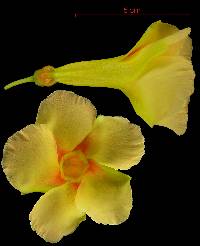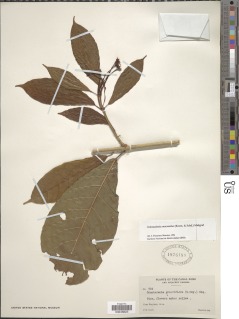

|
|
|
|
Family: Apocynaceae
[Odontadenia speciosa Benth.] |
Descripción: Plantas trepadoras o lianas con tronco marrón. Ramitas terminales verdes y con savia lechosa al cortarlas. Hojas simples y opuestas, membranáceas, de 11-24 x 4-10 cm, elípticas, con ápice redondeado o acuminado, bordes enteros y base obtusa o decurrente. Pecíolo de color rojizo. Flores amarillas y con la garganta de la corola anaranjada o roja. Frutos en folículos elipsoidales, de 13-23 x 4-5 cm. Semillas cubiertas por un penacho de pelos en el extremo apical. Especies Parecidas: A menudo se confunde con LK odo1pu Odontadenia puncticulosa LK2 , pero en O. puncticulosa las hojas presentan puntos negros por el envés y las flores son blancas o cremas, pero no tienen la garganta anaranjada o roja. Usos: La savia lechosa que secreta esta planta ocasiona irritaciones al contacto con la piel. O. grandiflora Miq.; O. hoffmannseggiana (Stead.) Woods. Liana, +/- glabrous; sap milky, copious in stems; stems hollow, with an interpetiolar ridge. Leaves opposite, sometimes alternate near apex; petioles 1-2 cm long, sometimes purplish; blades +/- elliptic, usually acuminate, obtuse to acute at base, 7-23 (36) cm long, 4-10 (17) cm wide, somewhat folded along midrib, the midrib +/- arched, impressed above with a distinct central rib in the groove. Thyrses axillary or terminal, irregularly branched, glabrous; peduncle 4-9 cm long; pedicels 1-2 (3) cm long; bracts minute; flowers ca 7 mm long; calyx lobes ovate, to 6 mm long, each with 1 or 2 squamellae inside; corolla funnelform, ca 6 cm long, orange-yellow, the lobes ca 3 cm long, spreading, tinged with red-orange inside near throat, the tube orange, bulbous, 5-lobed, ca 1 cm long, markedly constricted above stamens, the throat ca 3 cm long; stamens near base of tube; filaments and connective of the anthers densely short-pubescent; anthers sagittate, connate, glued to stigma; style 1; stigma l, fusiform. Follicles paired, obovoid when young, becoming oblong-ellipsoid at maturity, to 22 cm long and 6 cm wide, rounded at base, narrowly rounded and weakly oblique at apex, glabrous, green tinged with brown; seeds many, the seminiferous portion terete, brown, ca 4 cm long, narrowed to a slender stalk and bearing a plume of silky white trichomes ca 7 cm long at apex. Croat 8315,16597. Common in the forest and along the lakeshore. Flowers throughout the dry season and in the early rainy season, with the fruits maturing during the dry season of the following year. These widely dispersed, buoyant seeds are commonly found throughout the forest during the dry season. The trichomes of the plume are spreading to erect, with the seed usually suspended vertically. In O. puncticulosa, the trichomes of the plume are spread in all directions, but chiefly arched downward and below the seed. As a result, the alignment of the seed during flight is far less dependable than in O. macrantha. Costa Rica south through tropical South America; Trinidad. In Panama, known from tropical moist forest in the Canal Zone, San Blas, and Panama, from premontane dry forest in Herrera, and from premontane wet forest in Panama. |
|
|
|


























